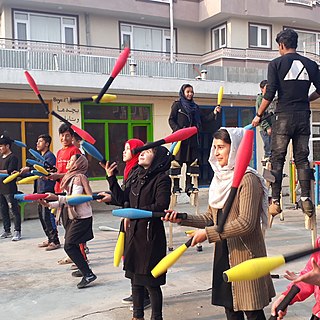
Juggling is a physical skill, performed by a juggler, involving the manipulation of objects for recreation, entertainment, art or sport. The most recognizable form of juggling is toss juggling. Juggling can be the manipulation of one object or many objects at the same time, most often using one or two hands but other body parts as well, like feet or head. Jugglers often refer to the objects they juggle as props. The most common props are balls, clubs, or rings. Some jugglers use more dramatic objects such as knives, fire torches or chainsaws. The term juggling can also commonly refer to other prop-based manipulation skills, such as diabolo, plate spinning, devil sticks, poi, cigar boxes, contact juggling, hooping, yo-yo, and hat manipulation.
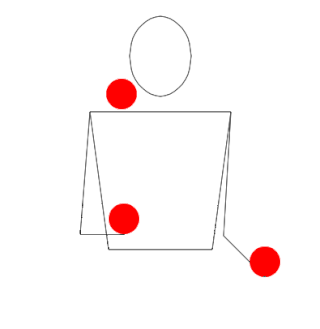
In toss juggling, a cascade is the simplest juggling pattern achievable with an odd number of props. The simplest juggling pattern is the three-ball cascade, This is therefore the first pattern that most jugglers learn. However, although the shower requires more speed and precision, "some people find that the movement comes naturally to them," and it may be the pattern learned first. "Balls or other props follow a horizontal figure-eight [or hourglass figure] pattern above the hands." In siteswap, each throw in a cascade is notated using the number of balls; thus a three ball cascade is "3".
In the cascade, an object is always thrown from a position near the body's midline in an arc passing underneath the preceding throw and toward the other side of the body, where it is caught and transported again toward the body's midline for the next throw. As a result, the balls travel along the figure-eight path that is characteristic of the cascade.

Siteswap, also called quantum juggling or the Cambridge notation, is a numeric juggling notation used to describe or represent juggling patterns. The term may also be used to describe siteswap patterns, possible patterns transcribed using siteswap. Throws are represented by non-negative integers that specify the number of beats in the future when the object is thrown again: "The idea behind siteswap is to keep track of the order that balls are thrown and caught, and only that." It is an invaluable tool in determining which combinations of throws yield valid juggling patterns for a given number of objects, and has led to previously unknown patterns. However, it does not describe body movements such as behind-the-back and under-the-leg. Siteswap assumes that "throws happen on beats that are equally spaced in time."

In toss juggling, Mills' Mess is a popular juggling pattern, typically performed with three balls although the props used and the number of objects can be different. The pattern was invented by and named after Steve Mills. It is a well-known trick among jugglers and learning it is considered somewhat of a milestone, "a mind-boggling pattern of circling balls, crossing and uncrossing hands, and unexpected catches."

Juggling clubs are a prop used by jugglers. Juggling clubs are often simply called clubs by jugglers and sometimes are referred to as pins or batons by non-jugglers. Clubs are one of the three most popular props used by jugglers; the others being balls and rings.
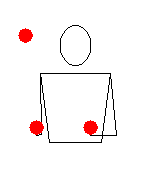
In toss juggling, the box is a juggling pattern for 3 objects, most commonly balls or bean bags. Two balls are dedicated to a specific hand with vertical throws, and the third ball is thrown horizontally between the two hands. Its siteswap is (4,2x)(2x,4).
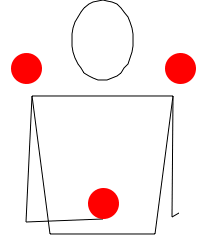
In toss juggling, columns, also known as One-up Two-up, is a juggling trick or pattern where the balls are thrown upwards without any sideways motion, distinguishing it from the fountain. The simplest version involves having three balls, with two going up simultaneously on either side, followed by one going up in the middle. One way to accomplish this is to juggle 2 balls in one hand and one ball in the other, so one hand has to move faster and further than in a regular pattern (cascade), whilst the other remains almost stationary. The hand juggling the center ball can alternate with each repeat to make the pattern symmetric.

Passing is the act of juggling between two or more people. It is most commonly seen as a subset of toss juggling.
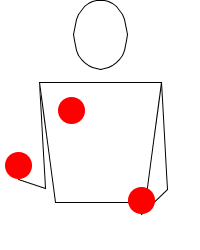
In toss juggling, Rubenstein's Revenge is a 3-ball juggling pattern named by George Gillson after its inventor, Rick Rubenstein. Along with Mills' Mess and Burke's Barrage, it is one of three well-known named juggling patterns that involve complex carries and crossed arm throws. Rubenstein's Revenge is usually considered the most involved and difficult of the three.

Toss juggling is the form of juggling which is most recognisable as 'juggling'. Toss juggling can be used as: a performing art, a sport, a form of exercise, as meditation, a recreational pursuit or hobby.
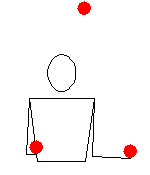
In toss juggling, the shower is a juggling pattern for 3 or more objects, most commonly balls or bean bags, where objects are thrown in a circular motion. Balls are thrown high from one hand to the other while the other hand passes the ball back horizontally. "In the shower pattern, every ball is thrown in a high arc from the right hand to the left and then quickly passed off with a low throw from the left to the right hand ." The animation depicts a 3-ball version. Siteswap notation for shower patterns is (2n-1)1, where n is the number of objects juggled. The circular motion of the balls is commonly represented in cartoons as the archetypical juggling pattern, somewhat at odds with reality, where the cascade is more common. By constantly reversing the direction, the box pattern can be formed.
Juggling practice has developed a wide range of patterns and forms which involve different types of manipulation, different props, numbers of props, and numbers of jugglers. The forms of juggling shown here are practiced by amateur, non-performing, hobby jugglers as well as by professional jugglers. The variations of juggling shown here are extensive but not exhaustive as juggling practice develops and creates new patterns on a regular basis. Jugglers do not consciously isolate their juggling into one of the categories shown; instead most jugglers will practice two or more forms, combining the varieties of juggling practice. Some forms are commonly mixed, for example: numbers and patterns with balls; while others are rarely mixed, for example: contact numbers passing. Many Western jugglers also practice other forms of object manipulation, such as diabolo, devil sticks, cigar box manipulation, fire-spinning, contact juggling, hat manipulation, poi, staff-spinning, balancing tricks, bar flair and general circus skills.

Juggling notation is the written depiction of concepts and practices in juggling. Toss juggling patterns have a reputation for being "easier done than said" – while it might be easy to learn a given maneuver and demonstrate it for others, it is often much harder to communicate the idea accurately using speech or plain text. To circumvent this problem, various numeric or diagram-based notation systems have been developed to facilitate communication of patterns or tricks between jugglers, as well the investigation and discovery of new patterns.

Juggling balls, or simply balls, are a popular prop used by jugglers, either on their own—usually in sets of three or more—or in combination with other props such as clubs or rings. A juggling ball refers to any juggling object that is roughly spherical in nature.

Juggling rings, or simply "rings", are a popular prop used by jugglers, usually in sets of three or more, or in combination with other props such as balls or clubs. The rings used by jugglers are typically about 30 centimetres (12 in) in diameter and 3 millimetres (0.12 in) thick.

A juggling pattern or juggling trick is a specific manipulation of props during the practice of juggling. "Juggling, like music, combines abstract patterns and mind-body coordination in a pleasing way." Descriptions of patterns and tricks have been most common in toss juggling. A juggling pattern in toss juggling is a sequence of throws and catches using a certain number of props which is repeated continuously. Patterns include simple ones such as the cascade and complex ones such as Mills mess. A juggling trick in toss juggling is a throw or catch which is different from the throws and catches within a pattern. Tricks include simple ones such as a high throw or more difficult ones such a catch on the back of the jugglers neck, as well as the claw, multiplex, and pass. Systems of juggling notation have been created to describe juggling patterns and tricks. One of these is siteswap notation.
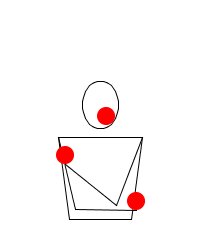
In toss juggling, a claw is a trick where the hand throwing or catching a ball is turned upside down so that the palm of the hand faces the ground. The effect is that of the jugglers hand appearing to snatch the ball out of the air. A claw can be juggled as an isolated trick, or be incorporated into an already existing juggling pattern. For example, the Boston Mess can be juggled with each right hand throw as a claw. The resulting pattern in known as cherry picking.
A juggling robot is a robot designed to be able to successfully carry out bounce or toss juggling. Robots capable of juggling are designed and built both to increase and test understanding and theories of human movement, juggling, and robotics. Juggling robots may include sensors to guide arm/hand movement or may rely on physical methods such as tracks or funnels to guide prop movement. Since true juggling requires more props than hands, many robots described as capable of juggling are not.
Juggling terminology, juggling terms:



















